Fast Track Agility Training in Your 40s for a Nimbler Future

Whether you’re a runner, golfer, Pilates aficionado or pickleball player – or a dedicated couch potato — your 40s are primetime for focusing on agility.
Why is 40 important? That’s because strength and muscle mass begin to decline when we hit our 40s. And if we do nothing, they can decline by 1 to 2 percent every year for lean muscle mass and up to 5 percent for strength.
If you’re in your 40s now, you may think you have fast reaction times, flexibility and strength, but it’s critical to pick up the pace on exercises that specifically target agility to retain your reaction times as you age. It’s an investment in your future.
When we lose muscle mass, we lose muscle fibers and the size of those muscle fibers also shrink. This is especially true of fast-twitch muscle fibers. Those fibers help us make quick, powerful movements. Slow-twitch fibers are designed for endurance. Our ability to repair muscles also diminishes as we age as our mix of hormones like testosterone and estrogen change.
So what do you do? Focus your workouts on maintaining and building those fast-twitch muscle fibers. Whether you’re an exercise newbie or you’re a gym rat, working multicomponent, time-efficient training exercises called plyometrics into your routine can help you specifically target agility.
In athletics, these fast-reaction moves are known as ‘explosive’ because they focus on short-burst, repetitive movements that stop, start and change directions – the latter being a major component of agility.
The physiological science of plyometrics and how and why it works is complex. Harvard Health experts think plyometrics improve the synchronization and efficiency of communication between your brain and fast-twitch muscle fibers in your lower body. They’re the muscle structures responsible for generating fast-reaction power and explosive strength to quickly redirect your body’s motion and direction while maintaining balance and stability. The short burst, explosive exercise drills of plyometrics increase the “excitability” of the brain’s neuroreceptors, which improves the neuromuscular system’s reactivity allowing for fast changes in movement — or agility.
The theory is that plyometric exercises increase your lower-body muscles’ reaction and enhance neuromuscular coordination, which enhances speed and automation. It’s why it’s a key exercise favored by football and basketball coaches to hone and sharpen players’ strength and ability to quickly react and change directions.
Plyometrics drills are also fun and can make you feel like a kid again. You can tailor them to fit your fitness level and capabilities. Here are four that plyometrics physiologists recommend (always check with your primary care doctor before changing your approach to exercise, especially if you have knee, hip or back joint issues or trouble with your balance):
Side jumps:
Standing feet together with your weight on your right foot, leap left as far as possible. Reverse the move and leap right to complete one rep and do three sets of 15 reps, pausing to rest between sets.
Forward hops:
With feet together, bend at the knees and jump forward one or two feet. Turn and jump back with the same motion. As you get comfortable and good at it, challenge yourself to jump higher and farther, even over something such as cushions or books. Do three sets of five to 10 hops with rest pauses between.
Jump rope:
Because jumping rope consists of quick and short explosive jumping with minimum ground contact, it perfectly epitomizes the intent of plyometric exercises to enhance coordination and reaction time. Start with three 30 -second to 2-minute sets of slow jumping with a rope and resting between sets, then increase your speed as you become proficient. Imitating the motion without a rope works just as well.
Agility ladder drills:
These vary from quickly running straight the length of an agility ladder (balance equipment resembling a ladder, typically of nylon rope with plastic or rubber cross pieces, laid on the floor) making sure both left and right feet touch down consecutively in each ladder space, to laterally running the length of the ladder sideways with the same approach. Or side-stepping left then right foot inside each space while zigzagging side to side moving quickly the length of the ladder. If you or your gym doesn’t have this equipment, you can also use chalk squares – think hopscotch — and create a version of a ladder.
